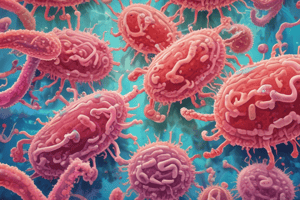Podcast
Questions and Answers
What is the primary focus of bacteriology?
What is the primary focus of bacteriology?
Which scientist first observed and described bacteria in the late 1600s?
Which scientist first observed and described bacteria in the late 1600s?
What is the role of bacteria in nutrient cycling?
What is the role of bacteria in nutrient cycling?
How are bacteria primarily identified in the clinical laboratory?
How are bacteria primarily identified in the clinical laboratory?
Signup and view all the answers
Which domain contains prokaryotic organisms according to the text?
Which domain contains prokaryotic organisms according to the text?
Signup and view all the answers
How do extremophile bacteria in the deep biosphere contribute to life?
How do extremophile bacteria in the deep biosphere contribute to life?
Signup and view all the answers
Who introduced the term 'bacteria' in the 1800s?
Who introduced the term 'bacteria' in the 1800s?
Signup and view all the answers
What led to the classification of bacteria based on their morphology?
What led to the classification of bacteria based on their morphology?
Signup and view all the answers
In the scientific classification of bacteria, what comes after the domain Bacteria?
In the scientific classification of bacteria, what comes after the domain Bacteria?
Signup and view all the answers
What distinguishes bacteria from viruses?
What distinguishes bacteria from viruses?
Signup and view all the answers
How do modern healthcare professionals classify pathogenic or epidemic strains of bacteria?
How do modern healthcare professionals classify pathogenic or epidemic strains of bacteria?
Signup and view all the answers
What revolutionized the treatment of bacterial infections in the early 1900s?
What revolutionized the treatment of bacterial infections in the early 1900s?
Signup and view all the answers
Study Notes
Bacteriology: The Study of Bacteria and Their Role in Our World
Introduction
Bacteriology is the branch of microbiology that deals with the study of bacteria, their classification, morphology, genetics, physiology, and evolution. Bacteria are unicellular, prokaryotic organisms that play a crucial role in various biological processes, including decomposition, nutrient recycling, and nitrogen fixation. They are ubiquitous and can be found in diverse environments, from soil and water to extreme environments like hydrothermal vents and radioactive waste.
Classification and Morphology
Bacteria are classified based on their morphology, genetics, and physiology. The domain Bacteria contains prokaryotic organisms with a diverse range of shapes, including rods (bacilli), spirals (spirochetes), and cocci (spherical). The scientific classification of bacteria includes the domain Bacteria, followed by a phylum, class, order, family, genus, and species.
Role in the Environment and Human Health
Bacteria play a vital role in maintaining the balance of ecosystems through decomposition and nutrient cycling. They are also responsible for the putrefaction stage in the decomposition of dead organisms. In the deep biosphere of Earth's crust, extremophile bacteria provide nutrients for life by converting dissolved compounds like hydrogen sulfide and methane into energy.
In human health, bacteria can be beneficial, harmful, or neutral. Most bacteria are harmless or rendered harmless by the human immune system. However, some bacteria cause infectious diseases, such as cholera, syphilis, anthrax, leprosy, tuberculosis, tetanus, and bubonic plague. Antibiotics are used to treat bacterial infections but can lead to antibiotic resistance, a growing concern in modern healthcare.
Bacterial Classification and Identification
Bacteria are identified in the clinical laboratory by morphological traits and biochemical tests, some of which are supplemented by serologic assessments. Strains of medical interest are often classified below the species level by serology or identification of toxins. Pathogenic or epidemic strains can be classified by the presence of a specific plasmid, plasmid profile, or bacteriophage susceptibility patterns. Newer molecular biologic techniques enable scientists to identify some species and strains by identifying a specific gene or genetic sequence, sometimes directly from clinical specimens.
History of Bacteriology
Bacteria were first observed and described by Leeuwenhoek in the late 1600s. However, it was not until the 1800s that the term "bacteria" was introduced by Christian Gottfried Ehrenberg. Louis Pasteur demonstrated the role of bacteria in fermentation and disease, and his work laid the foundation for the germ theory of disease. Ferdinand Cohn is considered one of the founders of bacteriology, and his work led to the classification of bacteria based on their morphology. The development of antibiotics in the early 1900s revolutionized the treatment of bacterial infections.
Conclusion
Bacteriology is a fascinating and diverse field that has a significant impact on our understanding of the world around us. From environmental health to human health, bacteria play a crucial role in maintaining the balance of ecosystems and supporting human life. The study of bacteria continues to evolve as new techniques and technologies are developed, allowing us to gain a deeper understanding of these fascinating organisms.
Studying That Suits You
Use AI to generate personalized quizzes and flashcards to suit your learning preferences.
Description
Explore the fascinating world of bacteriology, covering topics such as bacterial classification, morphology, environmental roles, human health impacts, and historical milestones in the field. Learn about the classification of bacteria, their ecological significance, and contributions to human welfare and disease. Delve into the historical discoveries and advancements that have shaped our understanding of these essential microorganisms.




